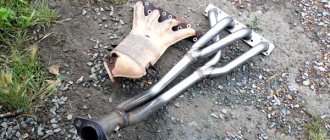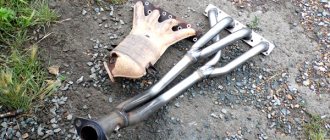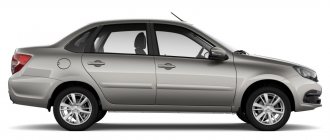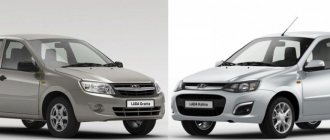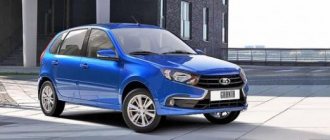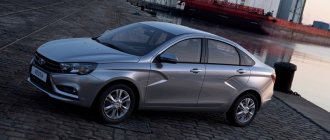Comparison of Lada Granta liftback and sedan
safety
suspension was installed on the luxury vehicle
, having gas-filled shock absorbers, thicker stabilizers and stiffer springs. Other trim levels come with the standard sedan suspension.
trunk for both a liftback and a hatchback.
. And although at first glance it is smaller than that of the sedan - 480 versus 440 liters, when folding the rear seats its volume increases by more than one and a half times (760 liters). These figures significantly exceed those of the Lada Kalina, the trunk limit of which stops at 670 liters.
The interior of the Lada Granta
has remained virtually unchanged compared to its sedan predecessor. The same console, instrument panel, the same seats. There is enough space in the back seat for three passengers to feel quite comfortable. The only question is the space above your head. If your height is 190 cm or less, you will be comfortable, but taller passengers will find the car uncomfortable.
Conducting
test drives of the Lada Granta liftback
, many drivers noted that the combination of a powerful engine and relatively low weight (1070 kg) provides decent dynamics for an inexpensive car. The main thing is not to accelerate the car above 150 km/h, since handling and directional stability at top speeds are not at all impressive. With a quiet ride, thanks to the elastic suspension, which is optimal for our roads, the Lada Granta leaves the most pleasant impression.
You can also reward
the brakes
, both during emergency and normal braking.
But the advertised sound insulation
raises complaints: when driving dynamically, the cabin is noisy, and you have to speak much louder to have a conversation. Installing additional sound insulation will solve the problem.
Average fuel consumption
in the city with a manual transmission it is 7.9 liters per hundred kilometers, while on the highway it is one liter less. “Automatic”, of course, is more voracious: on average 9.6 liters per hundred kilometers in the city and 8.5 on the highway. However, these are quite modest figures.
Summarizing _
, we can say that, despite certain shortcomings, the Lada Granta liftback fully justifies its price and has every chance of becoming a bestseller among economy class models. Finally, video review of the Lada Granta hatchback:
Comparative technical parameters of the sedan and liftback
- The engine displacement of both versions is identical and is 1.6 liters.
- Gas tanks have the same volume in terms of capacity, 50 liters each.
- In terms of luggage compartment capacity, the leader is the sedan with a value of 530 liters, while the liftback can only offer 440 liters of free space for luggage. If the latter folds down the rear backrests, the trunk will increase to 760 liters.
- If in terms of maximum speed the sedan is ahead: 182 km per hour versus 179, then in terms of dynamic capabilities the liftback is already on the pedestal (12.3 seconds to a hundred versus 14.2 seconds).
- The modifications are equipped with 8-valve engines in the LADA Granta sedan and more advanced units with 16-valve timing mechanisms. Both engines have the same displacement of 1.6 liters. The engine option with 8 valves will please you with its design simplicity and, therefore, cheaper maintenance. But for the 16-valve unit, higher levels of speed, power and dynamics are available.
Body differences
money-trans.ru The difference between subrogation and recourse.
What is the difference between recourse and subrogation under compulsory motor insurance. Cases of recourse in insurance Undoubtedly, two body types belong to the class of passenger cars. In terms of their properties and characteristics, they are equivalent to sedans. Now let's compare them:
- The liftback is very sedan-like due to its relatively long rear overhang;
- The hatchback has a one-volume body, i.e. the luggage compartment and interior are combined into one whole space;
- the liftback has a couple of versions for opening the rear door;
- Liftbacks are almost all two-volume, but there are also three-volume ones. *In addition, read the article " ".
Nevertheless, as a separate type of liftback body it is very difficult to distinguish; most people will classify it as one or another more common type of body.
Buying a car can be a very tedious process, especially if it is your first time. The future owner wants to satisfy all his needs. The choice depends on the cost of the car, the number of family members (for family people), the type of fuel, the age of the car (new or used)
Also, when buying a used car, special attention is paid to the number of owners, mileage and technical condition. However, today we will look at, in my opinion, the most important criterion for choosing a car, which determines its functionality
As you might have guessed, we will talk about body type.
Comparison of liftback and hatchback
As soon as car production began to be more large-scale than a couple of copies per year, then different types of cars began to appear, which were oriented towards certain needs. Comfortable sedans, sports coupes, luxurious convertibles and much, much more appeared. Today, due to design achievements and technological progress, many types of car bodies are combined in one, which is how crossovers, four-door coupes and others were born. But we will outline, perhaps, the most popular and clearly differentiated body types
:
- Sedan;
- Hatchback;
- Station wagon;
- Minivan;
- Coupe;
- Cabriolet;
- SUV.
However, the list goes on and the differences between types can be quite subtle. But we will study in detail and determine the differences between a hatchback and a liftback. Despite the fact that the liftback is, in fact, a subtype of the hatchback, they still have tangible features.
Examples of liftbacks
Modern examples of liftbacks include:
- Audi S7 Sportback second generation. The model appeared in the spring of 2019 at an online presentation;
- Volkswagen Polo 2nd generation, which was presented to the world of car enthusiasts also remotely at the beginning of 2022;
- Polestar 2. An electric car in the C-class liftback body was first presented at the beginning of 2019, and the first copy rolled off the assembly line in March 2020;
- Skoda Superb 3. A discreet and at the same time flashy mid-size car appeared in 2015;
- Opel Insignia Grand Sport, a 2nd generation business class model, appeared in 2016;
- Skoda Octavia third generation and modification RS 2013 and restyled edition 2016.
More budget options include:
- Lada Granta 2014, as well as a restyled version 2018;
- Chery QQ6 first appeared in 2006, but production ended in 2013;
- The well-known ZAZ-1103 “Slavuta” was produced in the period 1999-2011;
- Seat Toledo 4th generation was introduced in 2012;
- Toyota Prius of the second generation, which was produced between 2003-2009.

